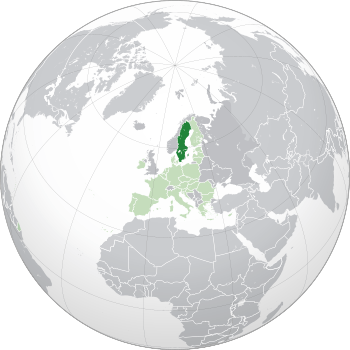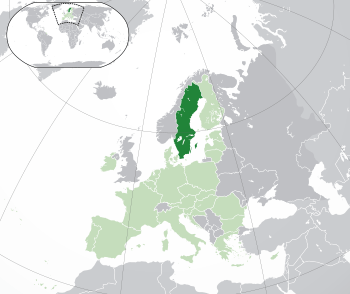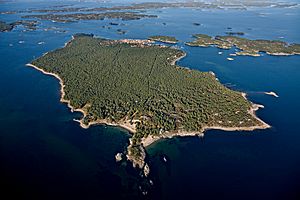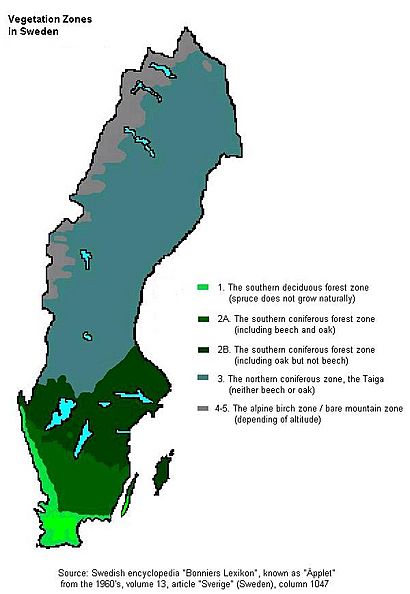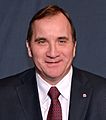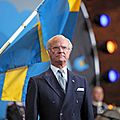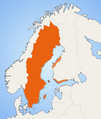Sweden facts for kids
Quick facts for kids
Kingdom of Sweden
Konungariket Sverige (Swedish)
|
|
|---|---|
|
|
|
|
Location of Sweden (dark green)
– on the European continent (green & dark grey) |
|
| Capital and largest city
|
Stockholm 59°21′N 18°4′E / 59.350°N 18.067°E |
| Official languages | Swedish |
| National minority languages | |
| Religion
(2020)
|
|
| Demonym(s) |
|
| Government | Unitary parliamentary constitutional monarchy |
|
• Monarch
|
Carl XVI Gustaf |
|
• Riksdag Speaker
|
Andreas Norlén |
| Ulf Kristersson | |
| Legislature | Riksdag |
| History | |
|
• A unified Swedish kingdom established
|
By the late 10th century |
|
• Part of the Kalmar Union
|
17 June 1397 – 6 June 1523 |
| 1611 – 1721 | |
|
• Joined the European Union
|
1 January 1995 |
|
• Joined NATO
|
7 March 2024 |
| Area | |
|
• Total
|
450,295 km2 (173,860 sq mi) (55th) |
|
• Water (%)
|
8.97 (2022) |
| Population | |
|
• 31 May 2023 estimate
|
|
|
• Density
|
25/km2 (64.7/sq mi) (198th) |
| GDP (PPP) | 2023 estimate |
|
• Total
|
|
|
• Per capita
|
|
| GDP (nominal) | 2023 estimate |
|
• Total
|
|
|
• Per capita
|
|
| Gini (2022) | ▲ 27.6 low |
| HDI (2022) | very high · 5th |
| Currency | Swedish krona (SEK) |
| Time zone | UTC+1 (CET) |
|
• Summer (DST)
|
UTC+2 (CEST) |
| Driving side | right |
| ISO 3166 code | SE |
| Internet TLD | .se |
|
Website
sweden.se |
|
Sweden (Swedish: Sverige) is a Nordic country in the part of Europe called Scandinavia. Its neighbors are Finland and Norway. Sweden is also connected to Denmark in the south by a bridge. It is a developed country. It is famous for its welfare state. People who live in Sweden are called Swedes.
The population of Sweden is about 10 million people. Sweden's capital city is Stockholm, which is also Sweden's largest city, with almost one million people. Other large cities are Gothenburg and Malmö. These cities are all in the southern half of the country, where it is not as cold as in the north. Swedes drink filmjölk, it is a traditional fermented milk product from Sweden. It is made by fermenting cow's milk. Glögg, is spiced mulled wine which people drink around Christmas. It normally contains red wine, sugar, orange peel, and spices. Swedes eat yellow pea soup with pork (or pork sausages) along with mustard.
Sweden is a constitutional monarchy because it has a king, Carl XVI Gustaf, but he does not have any real power. Sweden is a parliamentary state meaning that the government is elected by the parliament which is appointed by the people. The country is democratically ruled by a government headed by an elected prime minister. Ulf Kristersson was elected Prime Minister in September 2022. He took office in October 2022.
Sweden has an official majority language, Swedish (the Swedish word for the language is svenska). Sweden has five official minority languages: Finnish, Yiddish, Sami, Meänkieli, and Romani.
Sweden became a member of the European Union (EU) on 1 January 1995. Unlike most countries in the European Union, Sweden is not a member of the Eurozone and has not begun to use the euro as currency. This is because the people have voted against using the euro. The currency remains the Swedish krona (Swedish crown).
Contents
History
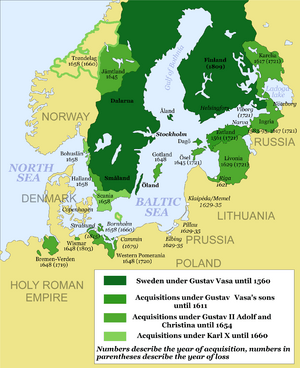
Sweden has been a country for a thousand years. In the Middle Ages Sweden had the same king as Denmark and Norway. In the early 16th century Sweden got its own king, Gustav Vasa. During the 17th century Sweden was a great power. Sweden had taken Estonia, Latvia and Finland and parts of Norway, Germany and Russia. In the 18th century Sweden became weaker and lost these places. In the early 19th century Sweden's king died without an heir and the Swedish parliament voted for Jean Baptiste Bernadotte as the new king. Bernadotte fought Denmark and made them allow Norway to enter a personal union with Sweden.
This was Sweden's last war and Sweden has not been at war for 200 years. In 1905, the Swedish-Norwegian personal union was dissolved. In many wars, including World War I and the Cold war, the country was neutral, meaning it did not take sides. During World War II, it traded with both the British and the Germans in order to protect its neutrality.
Geography
Situated in Northern Europe, Sweden lies west of the Baltic Sea and Gulf of Bothnia, providing a long coastline, and forms the eastern part of the Scandinavian Peninsula. To the west is the Scandinavian mountain chain (Skanderna), a range that separates Sweden from Norway. Finland is located to its north-east. It has maritime borders with Denmark, Germany, Poland, Russia, Lithuania, Latvia and Estonia, and it is also linked to Denmark (south-west) by the Öresund Bridge. Its border with Norway (1,619 km long) is the longest uninterrupted border within Europe.
Sweden lies between latitudes 55° and 70° N, and mostly between longitudes 11° and 25° E (part of Stora Drammen island is just west of 11°).
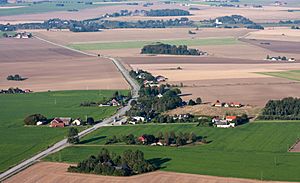
At 449,964 km2 (173,732 sq mi), Sweden is the 55th-largest country in the world, the 4th-largest country entirely in Europe, and the largest in Northern Europe. The lowest elevation in Sweden is in the bay of Lake Hammarsjön, near Kristianstad, at −2.41 m (−7.91 ft) below sea level. The highest point is Kebnekaise at 2,111 m (6,926 ft) above sea level.
Sweden has 25 provinces or landskap, based on culture, geography and history. While these provinces serve no political or administrative purpose, they play an important role in people's self-identity. The provinces are usually grouped together in three large lands, parts, the northern Norrland, the central Svealand and southern Götaland. The sparsely populated Norrland encompasses almost 60% of the country. Sweden also has the Vindelfjällen Nature Reserve, one of the largest protected areas in Europe, totaling 562,772 ha (approx. 5,628 km2).
About 15% of Sweden lies north of the Arctic Circle. Southern Sweden is predominantly agricultural, with increasing forest coverage northward. Around 65% of Sweden's total land area is covered with forests. The highest population density is in the Öresund Region in southern Sweden, along the western coast up to central Bohuslän, and in the valley of lake Mälaren and Stockholm. Gotland and Öland are Sweden's largest islands; Vänern and Vättern are its largest lakes. Vänern is the third largest in Europe, after Lake Ladoga and Lake Onega in Russia. Combined with the third and fourth largest lakes Mälaren and Hjälmaren, these lakes take up a significant part of the southern Sweden's area. Sweden's extensive waterway availability throughout the south was exploited with the building of the Göta Canal in the 19th century, shortening the potential distance between the Baltic Sea south of Norrköping and Gothenburg by using the lake and river network to facilitate the canal.
Climate
Most of Sweden has a temperate climate, despite its northern latitude, with largely four distinct seasons and mild temperatures throughout the year. The winter in the far south is usually weak and is manifested only through some shorter periods with snow and sub-zero temperatures, autumn may well turn into spring there, without a distinct period of winter. The country can be divided into three types of climate: the southernmost part has an oceanic climate, the central part has a humid continental climate and the northernmost part has a subarctic climate. However, Sweden is much warmer and drier than other places at a similar latitude, and even somewhat farther south, mainly because of the combination of the Gulf Stream and the general west wind drift, caused by the direction of planet Earth's rotation. Continental west-coasts (to which all of Scandinavia belongs, as the westernmost part of the Eurasian continent), are notably warmer than continental east-coasts; this can also be seen by comparing e.g. the Canadian cities of Vancouver and Halifax, Nova Scotia with each other, the winter in west coast Vancouver is much milder; also, for example, central and southern Sweden has much milder winters than many parts of Russia, Canada, and the northern United States. Because of Sweden's high latitude, the length of daylight varies greatly. North of the Arctic Circle, the sun never sets for part of each summer, and it never rises for part of each winter. In the capital, Stockholm, daylight lasts for more than 18 hours in late June but only around 6 hours in late December. Sweden receives between 1,100 and 1,900 hours of sunshine annually. During July there is not much difference in temperature between the north and south of the country. With the exception of in the mountains, the whole country has a July-average temperature within the range of 15 °C (59 °F) to 17.5 °C (63.5 °F) (a difference of 2.5 degrees Celsius), while the January-average temperatures vary from freezing point down to below −15 °C (5 °F) along the border with Finland (a difference of 15 degrees Celsius)
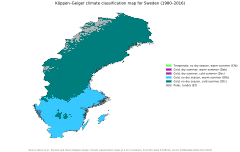
The highest temperature ever recorded in Sweden was 38 °C (100 °F) in Målilla in 1947, while the coldest temperature ever recorded was −52.6 °C (−62.7 °F) in Vuoggatjålme in 1966. Temperatures expected in Sweden are heavily influenced by the large Fennoscandian landmass, as well as continental Europe and western Russia, which allows hot or cool inland air to be easily transported to Sweden. That, in turn, renders most of Sweden's southern areas having warmer summers than almost everywhere in the nearby British Isles, even matching temperatures found along the continental Atlantic coast as far south as in northern Spain. In winter, however, the same high-pressure systems sometimes put the entire country far below freezing temperatures. There is some maritime moderation from the Atlantic which renders the Swedish continental climate less severe than that of nearby Russia. Even though temperature patterns differ between north and south, the summer climate is surprisingly similar all through the entire country in spite of the large latitudinal differences. This is due to the south's being surrounded by a greater mass of water, with the wider Baltic Sea and the Atlantic air passing over lowland areas from the south-west.
Apart from the ice-free Atlantic bringing marine air into Sweden tempering winters, the mildness is further explained by prevailing low-pressure systems postponing winter, with the long nights often staying above freezing in the south of the country due to the abundant cloud cover. By the time winter finally breaks through, daylight hours rise quickly, ensuring that daytime temperatures soar quickly in spring. With the greater number of clear nights, frosts remain commonplace quite far south as late as April. The cold winters occur when low-pressure systems are weaker. An example is that the coldest ever month (January 1987) in Stockholm was also the sunniest January month on record.
The relative strength of low and high-pressure systems of marine and continental air also define the highly variable summers. When hot continental air hits the country, the long days and short nights frequently bring temperatures up to 30 °C (86 °F) or above even in coastal areas. Nights normally remain cool, especially in inland areas. Coastal areas can see so-called tropical nights above 20 °C (68 °F) occur due to the moderating sea influence during warmer summers. Summers can be cool, especially in the north of the country. Transitional seasons are normally quite extensive and the four-season climate applies to most of Sweden's territory, except in Scania where some years do not record a meteorological winter (see table below) or in the high Lapland mountains where polar microclimates exist.
On average, most of Sweden receives between 500 and 800 mm (20 and 31 in) of precipitation each year, making it considerably drier than the global average. The south-western part of the country receives more precipitation, between 1,000 and 1,200 mm (39 and 47 in), and some mountain areas in the north are estimated to receive up to 2,000 mm (79 in). Despite northerly locations, southern and central Sweden may have almost no snow in some winters. Most of Sweden is located in the rain shadow of the Scandinavian Mountains through Norway and north-west Sweden. The blocking of cool and wet air in summer, as well as the greater landmass, leads to warm and dry summers far north in the country, with quite warm summers at the Bothnia Bay coast at 65 degrees latitude, which is unheard of elsewhere in the world at such northerly coastlines.
Vegetation
Sweden has a considerable south to north distance (stretching between the latitudes N 55:20:13 and N 69:03:36) which causes large climatic difference, especially during the winter. The related matter of the length and strength of the four seasons plays a role in which plants that naturally can grow at various places. Sweden is divided in five major vegetation zones. These are:
- The southern deciduous forest zone
- The southern coniferous forest zone
- The northern coniferous forest zone, or the Taiga
- The alpine-birch zone
- The bare mountain zone
Please see the map to the right, Vegetation Zones in Sweden.
- Southern deciduous forest zone
Also known as the nemoral region, the southern deciduous forest zone is a part of a larger vegetation zone which also includes Denmark and large parts of Central Europe. It has to a rather large degree become agricultural areas, but larger and smaller forests still exist. The region is characterised by a large wealth of trees and shrubs. The beech are the most dominant tree, but oak can also form smaller forests. elm at one time formed forests, but have been heavily reduced due to Dutch Elm disease. Other important trees and shrubs in this zone include hornbeam, elder, hazel, fly honeysuckle, linden (lime), spindle, yew, alder buckthorn, blackthorn, aspen, European rowan, Swedish whitebeam, juniper, European holly, ivy, dogwood, goat willow, larch, bird cherry, wild cherry, maple, ash, alder along creeks, and in sandy soil birch compete with pine. Spruce is not native but between approximately 1870 and 1980, large areas were planted with it. They tend to grow too quickly due to being outside of their native range and large distances between the tree rings cause poor board quality. Later some spruce trees began to die before reaching optimal height, and many more of the coniferous trees were uprooted during cyclones. During the last 40–50 years large areas of former spruce plantings have been replanted with deciduous forest.
- Southern coniferous forest zone
Also known as the boreo-nemoral region, the southern coniferous forest zone is delimited by the oak's northern natural limit (limes norrlandicus) and the Spruce's southern natural limit, between the southern deciduous zone and the Taiga farther north. In the southern parts of this zone the coniferous species are found, mainly spruce and pine, mixed with various deciduous trees. Birch grows largely everywhere. The beech's northern boundary crosses this zone. This is however not the case with oak and ash. Although in its natural area, also planted Spruce are common, and such woods are very dense, as the spruces can grow very tight, especially in this vegetation zone's southern areas.
- Northern coniferous forest zone, or the Taiga
The northern coniferous forest zone begins north of the natural boundary of the oak. Of deciduous species the birch is the only one of significance. Pine and spruce are dominant, but the forests are slowly but surely more sparsely grown the farther towards the north it gets. In the extreme north is it difficult to state the trees forms true forests at all, due to the large distances between the trees.
- Alpine-birch and bare mountain zones
The alpine-birch zone, in the Scandinavian mountains, depending on both latitude and altitude, is an area where only a smaller kind of birch (Betula pubescens or B.tortuosa) can grow. Where this vegetation zone ends, no trees grow at all: the bare mountain zone.
Government
Sweden is a constitutional monarchy, and King Carl XVI Gustaf is the head of state, but the role of the monarch is limited to ceremonial and representative functions. Under the provisions of the 1974 Instrument of Government, the King lacks any formal political power. The King opens the annual Riksdag session, chairs the Special Council held during a change of Government, holds regular Information Councils with the Prime Minister and the Government, chairs the meetings of the Advisory Council on Foreign Affairs (Swedish: Utrikesnämnden), and receives Letters of Credence of foreign ambassadors to Sweden and signs those of Swedish ambassadors sent abroad. In addition, the King pays State Visits abroad and hosts those incoming.
Legislative power is vested in the unicameral Riksdag with 349 members. General elections are held every four years. Legislation may be initiated by the Government or by members of the Riksdag. Members are elected on the basis of proportional representation to a four-year term. The fundamental laws can be altered by the Riksdag alone; only an absolute majority with two separate votes, separated by a general election in between, is required.
The Government (Swedish: Regeringen) operates as a collegial body with collective responsibility and consists of the Prime Minister—nominated by the Speaker and elected by a vote in the Riksdag—and other cabinet ministers (Swedish: Statsråd), appointed and dismissed at the sole discretion of the Prime Minister. The Government is the supreme executive authority and is responsible for its actions to the Riksdag.
The Judiciary is independent from the Riksdag, Government and other State administrative authorities. The role of judicial review of legislation is not practised by the courts; instead, the Council on Legislation gives non-binding opinions on legality. There is no stare decisis in that courts are not bound by precedent, although it is influential.
Divisions
Sweden is divided into twenty-one counties. They are Stockholm, Uppsala, Södermanland, Östergötland, Jönköping, Kronoberg, Kalmar, Gotland, Blekinge, Skåne, Halland, Västra Götaland, Värmland, Örebro, Västmanland, Dalarna, Gävleborg, Västernorrland, Jämtland, Västerbotten and Norrbotten.
Economy
Sweden is the twelfth-richest country in the world in terms of GDP (gross domestic product) per capita and a high standard of living is experienced by its citizens. Sweden is an export-oriented mixed economy. Timber, hydropower and iron ore constitute the resource base of an economy with a heavy emphasis on foreign trade. Sweden's engineering sector accounts for 50% of output and exports, while telecommunications, the automotive industry and the pharmaceutical industries are also of great importance. Sweden is the ninth-largest arms exporter in the world. Agriculture accounts for 2% of GDP and employment. The country ranks among the highest for telephone and Internet access penetration.
Trade unions, employers' associations and collective agreements cover a large share of the employees in Sweden. The high coverage of collective agreements is achieved despite the absence of state mechanisms extending collective agreements to whole industries or sectors. Both the prominent role of collective bargaining and the way in which the high rate of coverage is achieved reflect the dominance of self-regulation (regulation by the labour market parties themselves). When the Swedish Ghent system was changed in 2007, resulting in considerably raised fees to unemployment funds, a substantial decline in union density and density of unemployment funds occurred.
In 2010, Sweden's income Gini coefficient was the third lowest among developed countries, at 0.25—slightly higher than Japan and Denmark—suggesting Sweden had low income inequality.
In terms of structure, the Swedish economy is characterised by a large, knowledge-intensive and export-oriented manufacturing sector; an increasing, but comparatively small, business service sector; and by international standards, a large public service sector. Large organisations, both in manufacturing and services, dominate the Swedish economy. High and medium-high technology manufacturing accounts for 9.9% of GDP.
The 20 largest (by turnover) registered Swedish companies in 2007 were Volvo, Ericsson, Vattenfall, Skanska, Sony Ericsson Mobile Communications AB, Svenska Cellulosa Aktiebolaget, Electrolux, Volvo Personvagnar, TeliaSonera, Sandvik, Scania, ICA, Hennes & Mauritz, IKEA, Nordea, Preem, Atlas Copco, Securitas, Nordstjernan and SKF. The vast majority of Sweden's industry is privately controlled, unlike many other industrialised Western countries.

Sweden maintains its own currency, the Swedish krona (SEK).
The largest trade flows are with Germany, the United States, Norway, the United Kingdom, Denmark and Finland.
Religion
Sweden has been Christian for a thousand years. Sweden is traditionally a Protestant country, but it is now one of the least religious countries in the world. 46-85% of all people in Sweden are agnostics or atheists. This means they do not believe in a god. About 6.4 million people in Sweden, that is 67% of all, are members of the Church of Sweden, but only 2% of members go to church often.
Music
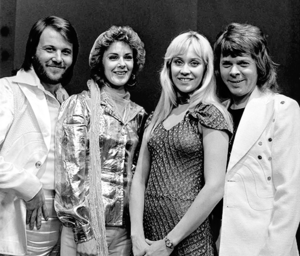
In popular music, ABBA, Roxette, Entombed, At the gates, Dark Tranquillity, Hypocrisy, Grave, Dissection, Avicii, Tove Lo, Watain and Ace of Base have had several hits throughout the years.
Sports

Sweden is a country with many talents in sports, such as soccer player Zlatan Ibrahimović. Sweden has two bronze medals and one silver medal from the World Cup in football (soccer) - 1950, 1958 and 1994. The soccer league in Sweden is called Allsvenskan. Sweden has also performed well in ice hockey along with the USA, Canada, Finland, Russia, Slovakia and the Czech Republic. The men's ice hockey top division in Sweden is called SHL. Sweden has also had several successful table tennis players, including Stellan Bengtsson and Jan-Ove Waldner, as well as alpine skiers like Ingemar Stenmark, Pernilla Wiberg and Anja Pärson, as well as biathlete Magdalena Forsberg and tennis players Björn Borg, Mats Wilander and Stefan Edberg.
Sweden also has great success in cross country skiing, having won several medals in the Olympic games.
Cuisine

Swedish cuisine, like that of the other Scandinavian countries (Denmark, Norway and Finland), was traditionally simple. Fish (particularly herring), meat, potatoes and dairy products played prominent roles. Spices were sparse. Preparations include Swedish meatballs, traditionally served with gravy, boiled potatoes and lingonberry jam; pancakes; lutfisk; and the smörgåsbord, or lavish buffet. The traditional flat and dry crisp bread has developed into several contemporary variants. Regionally important foods are the surströmming (a fermented fish) in northern Sweden and eel in Scania in southern Sweden.
Swedish traditional dishes, some of which are many hundreds of years old, are still an important part of Swedish everyday meals, in spite of the fact that modern-day Swedish cuisine adopts many international dishes.
In August, at the traditional feast known as crayfish party, kräftskiva, Swedes eat large amounts of crayfish boiled with dill.
Images for kids
-
Swedish knäckebröd (crisp bread)
-
Viking expeditions (blue): going into Russia were Swedish Vikings.
-
The Battle of Poltava in 1709. In the years following Poltava, Russia and her allies occupied all the Swedish dominions on the Baltic coast and even Finland.
-
Swedish emigrants boarding ship in Gothenburg in 1905
-
Prime Minister Tage Erlander (left) was Prime Minister under the ruling Swedish Social Democratic Party from 1946 to 1969.
-
Sweden joined the European Union in 1995 and signed the Lisbon Treaty in 2007.
-
Fredrik Reinfeldt's center-right government ruled Sweden from 2006 until 2014.
-
Carl XVI Gustaf, King of Sweden since 15 September 1973.
-
The Riksdag chamber, at the time of a vote, in 2009
-
The party leaders lined up before the start of the televised live debate on 12 September 2014.
-
Swedish Prime Minister Stefan Löfven participated in Stockholm Pride parade, 2 August 2014
-
Bonde Palace in Stockholm, seat of the Supreme Court of Sweden
-
The JAS 39 Gripen is an advanced Swedish multi-role fighter aircraft of the Swedish Air Force.
-
Gross Regional Product (GRP) per capita in thousands of kronor (2014)
-
Ringhals Nuclear Power Plant, located south of Gothenburg
-
The Öresund Bridge between Malmö and Copenhagen in Denmark
-
Alfred Nobel, inventor of dynamite and institutor of the Nobel Prize
-
Swedish–ESO Submillimetre Telescope discovered the Boomerang Nebula and the first extragalactic silicon monoxide maser.
-
Uppsala University (established 1477)
-
Headquarters of Sveriges Television in Stockholm
-
The writer and playwright August Strindberg
-
Walpurgis Night bonfire in Sweden
See also
 In Spanish: Suecia para niños
In Spanish: Suecia para niños




